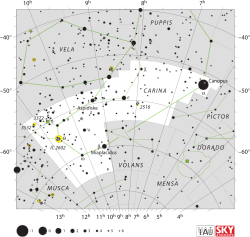Epsilon Carinae

Location of ε Carinae (circled) | |
| Observation data Epoch J2000 Equinox J2000 | |
|---|---|
| Constellation | Carina |
| Right ascension | 08h 22m 30.83526s[1] |
| Declination | −59° 30′ 34.1431″[1] |
| Apparent magnitude (V) | 1.86[2] (2.166/4.121)[3] |
| Characteristics | |
| Spectral type | K3 III[4] + B2 Vp[5] |
| U−B color index | +0.19[2] |
| B−V color index | +1.27[2] |
| Variable type | Eclipsing (suspected)[6] |
| Astrometry | |
| Radial velocity (Rv) | +11.6[7] km/s |
| Proper motion (μ) | RA: –25.52[1] mas/yr Dec.: 22.72[1] mas/yr |
| Parallax (π) | 5.39 ± 0.42[1] mas |
| Distance | 610 ± 50 ly (190 ± 10 pc) |
| Details | |
| ε Car A | |
| Mass | 9.0 ± 0.9[8] M☉ |
| Temperature | 3,523[9] K |
| Age | 31.2 ± 10.1[8] Myr |
| ε Car B | |
| Mass | 7.30[9] M☉ |
| Temperature | 20,417[9] K |
| Other designations | |
| Database references | |
| SIMBAD | data |
Epsilon Carinae (ε Car, ε Carinae) is a star in the southern constellation of Carina. It is also known by the name Avior. At apparent magnitude +1.86 it is one of the brightest stars in the night sky, but is not visible from the northern hemisphere.

Epsilon Carinae is a double star located roughly 560–660 light-years (170–200 parsecs) away from the Earth.[1] Measurements during the Hipparcos mission give the pair an angular separation of 0.46 arcseconds with a difference in magnitude of 2.0.[5] At their estimated distance, this angle is equivalent to a physical separation of around 4 Astronomical Units.[11] This pair may form an eclipsing binary system[11] with a period of 785 days (2.15 years), resulting in a magnitude change of 0.12 during each eclipse.[6][12]
The primary component has an apparent visual magnitude of 2.2,[3] which by itself would still make it the third brightest star in the constellation. It is an evolved giant star with a stellar classification of K0 III. However, examination of the ultraviolet flux from this star suggests it may instead be of spectral type K7.[5] The fainter secondary companion has an apparent visual magnitude of 4.1,[3] which, if it were a solitary star, would be bright enough to be seen with the naked eye. This is a hot, core hydrogen-fusing B-type main sequence star of spectral class B2 Vp.[5] The secondary may itself have an orbiting stellar companion of spectral class F8:.[9]
Etymology
The name Avior is not a classical in origin. It was assigned to the star by Her Majesty's Nautical Almanac Office in the late 1930s during the creation of The Air Almanac, a navigational almanac for the Royal Air Force. Of the fifty-seven navigation stars included in the new almanac, two had no classical names: Epsilon Carinae and Alpha Pavonis. The RAF insisted that all of the stars must have names, so new names were invented. Alpha Pavonis was named "Peacock", a translation of Pavo, whilst Epsilon Carinae was called "Avior".[13]
In Chinese, 海石 (Hǎi Dàn), meaning Sea Rock, refers to an asterism consisting of ε Carinae, ι Carinae, HD 83183, HD 84810 and υ Carinae .[14] Consequently, ε Carinae itself is known as 海石一 (Hǎi Dàn yī, English: the First Star of Sea Rock.)[15]
References
- ↑ 1.0 1.1 1.2 1.3 1.4 1.5 van Leeuwen, F. (November 2007), "Validation of the new Hipparcos reduction", Astronomy and Astrophysics 474 (2): 653–664, arXiv:0708.1752, Bibcode:2007A&A...474..653V, doi:10.1051/0004-6361:20078357.
- ↑ 2.0 2.1 2.2 Johnson, H. L. et al. (1966), "UBVRIJKL photometry of the bright stars", Communications of the Lunar and Planetary Laboratory 4 (99), Bibcode:1966CoLPL...4...99J.
- ↑ 3.0 3.1 3.2 Fabricius, C.; Makarov, V. V. (April 2000), "Two-colour photometry for 9473 components of close Hipparcos double and multiple stars", Astronomy and Astrophysics 356: 141–145, Bibcode:2000A&A...356..141F.
- ↑ Houk, Nancy (1978), Michigan catalogue of two-dimensional spectral types for the HD stars 1, Ann Arbor: Dept. of Astronomy, University of Michigan, Bibcode:1975mcts.book.....H.
- ↑ 5.0 5.1 5.2 5.3 Parsons, Sidney B.; Ake, Thomas B. (November 1998), "Ultraviolet and Optical Studies of Binaries with Luminous Cool Primaries and Hot Companions. V. The Entire IUE Sample", The Astrophysical Journal Supplement Series 119 (1): 83–104, Bibcode:1998ApJS..119...83P, doi:10.1086/313152.
- ↑ 6.0 6.1 Hoffleit, Dorrit; Warren Jr, W. H., The Bright Star Catalogue (5th revised ed.), Smithsonian Astrophysical Observatory, retrieved 2012-02-12.. See: VizieR V/50
- ↑ Evans, D. S. (June 20–24, 1966), "The Revision of the General Catalogue of Radial Velocities", in Batten, Alan Henry; Heard, John Frederick, Determination of Radial Velocities and their Applications, Proceedings from IAU Symposium no. 30, University of Toronto: International Astronomical Union, Bibcode:1967IAUS...30...57E.
- ↑ 8.0 8.1 Tetzlaff, N.; Neuhäuser, R.; Hohle, M. M. (January 2011), "A catalogue of young runaway Hipparcos stars within 3 kpc from the Sun", Monthly Notices of the Royal Astronomical Society 410 (1): 190–200, arXiv:1007.4883, Bibcode:2011MNRAS.410..190T, doi:10.1111/j.1365-2966.2010.17434.x.
- ↑ 9.0 9.1 9.2 9.3 Parsons, Sidney B. (May 2004), "New and Confirmed Triple Systems with Luminous Cool Primaries and Hot Companions", The Astronomical Journal 127 (5): 2915–2930, Bibcode:2004AJ....127.2915P, doi:10.1086/383546.
- ↑ "eps Car -- Double or multiple star", SIMBAD Astronomical Object Database (Centre de Données astronomiques de Strasbourg), retrieved 2012-02-12.
- ↑ 11.0 11.1 Kaler, James B., "AVIOR (Epsilon Carinae)", Stars (University of Illinois), retrieved 2012-02-12.
- ↑ Hoffleit, Dorrit (1996), "A Catalogue of Correlations Between Eclipsing Binaries and Other Categories of Double Stars", The Journal of the American Association of Variable Star Observers 24 (2): 105–116, Bibcode:1996JAVSO..24..105H
- ↑ Safler, D. H., Wilkins, G. A., ed., A Personal History of H.M. Nautical Almanac Office (PDF), Sidford, Devon: Unpublished, p. 4.
- ↑ (Chinese) 中國星座神話, written by 陳久金. Published by 台灣書房出版有限公司, 2005, ISBN 978-986-7332-25-7.
- ↑ (Chinese) 香港太空館 - 研究資源 - 亮星中英對照表, Hong Kong Space Museum. Accessed on line November 23, 2010.
| ||||||||||||||||||||